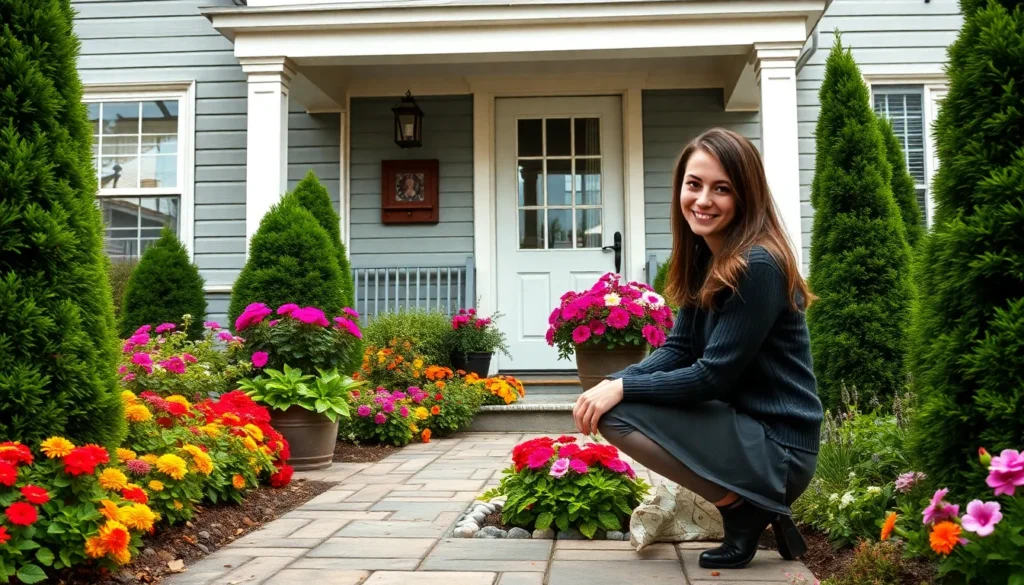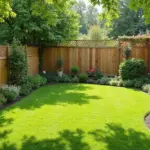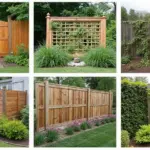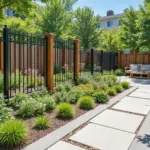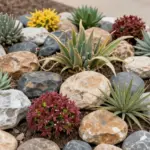Your front porch serves as the first impression guests get of your home, and we believe it deserves to make a stunning statement. Whether you’re working with a grand wraparound porch or a cozy entryway, the right landscaping can transform this space from ordinary to extraordinary.
We’ve discovered that strategic plant placement, creative container gardens, and thoughtful design elements can dramatically boost your home’s curb appeal while creating a welcoming atmosphere. From seasonal color schemes to low-maintenance perennials, there’s a landscaping solution that’ll perfectly complement your porch’s style and your lifestyle.
The best part? You don’t need a massive budget or professional expertise to achieve these eye-catching results. We’re here to share proven front porch landscaping ideas that’ll help you create an inviting entrance that neighbors will admire year-round.
Create a Welcoming Entrance With Foundation Plantings
Foundation plantings serve as the visual bridge between your home’s architecture and the natural industry. We’ll show you how strategic plant choices can transform your front porch area into an inviting focal point.
Choose Low-Maintenance Evergreen Shrubs
Low-maintenance evergreen shrubs provide year-round structure and color without demanding constant attention. Boxwood, yew, and holly varieties offer excellent foundation planting options that maintain their appearance through all seasons. We recommend planting these sturdy performers in groups of three or five for maximum visual impact.
Dwarf varieties work particularly well for front porch landscaping since they won’t outgrow their designated spaces. Japanese pieris and compact rhododendrons add texture while requiring minimal pruning throughout the year. These evergreen selections create a consistent backdrop that anchors your entire industry design.
Consider the mature size of each shrub before planting to avoid overcrowding issues later. Spacing evergreens properly allows air circulation and prevents disease problems that plague tightly packed plantings.
Add Seasonal Color With Flowering Perennials
Flowering perennials inject vibrant color into your foundation plantings while returning year after year. Hostas, astilbe, and coral bells thrive in partially shaded areas near front porches and offer stunning foliage variations. We suggest mixing different bloom times to ensure continuous color from spring through fall.
Daylilies and black-eyed Susans perform exceptionally well in sunnier front porch locations. These reliable bloomers produce flowers for weeks and require minimal care once established. Plant them in front of your evergreen shrubs to create depth and seasonal interest.
Native perennials like purple coneflower and bee balm attract beneficial pollinators while reducing maintenance requirements. These hardy plants adapt to local growing conditions and provide natural beauty that changes with each passing season.
Layer Plants by Height for Visual Interest
Layering plants by height creates dimensional depth that draws the eye toward your front porch entrance. Tall evergreen shrubs form the background layer against your home’s foundation walls. We position medium-height perennials in the middle tier to bridge the gap between tall and short plantings.
Ground covers and low-growing annuals complete the front layer of your foundation design. Creeping phlox, ajuga, and pachysandra spread naturally to fill gaps while suppressing weed growth. This layered approach mimics natural forest ecosystems and creates visual movement throughout your industry.
Edge your planting beds with defined borders using stone, brick, or metal edging materials. Clean lines help separate your layered plantings from lawn areas and create a polished appearance that enhances your front porch landscaping design.
Design Stunning Container Gardens for Flexibility
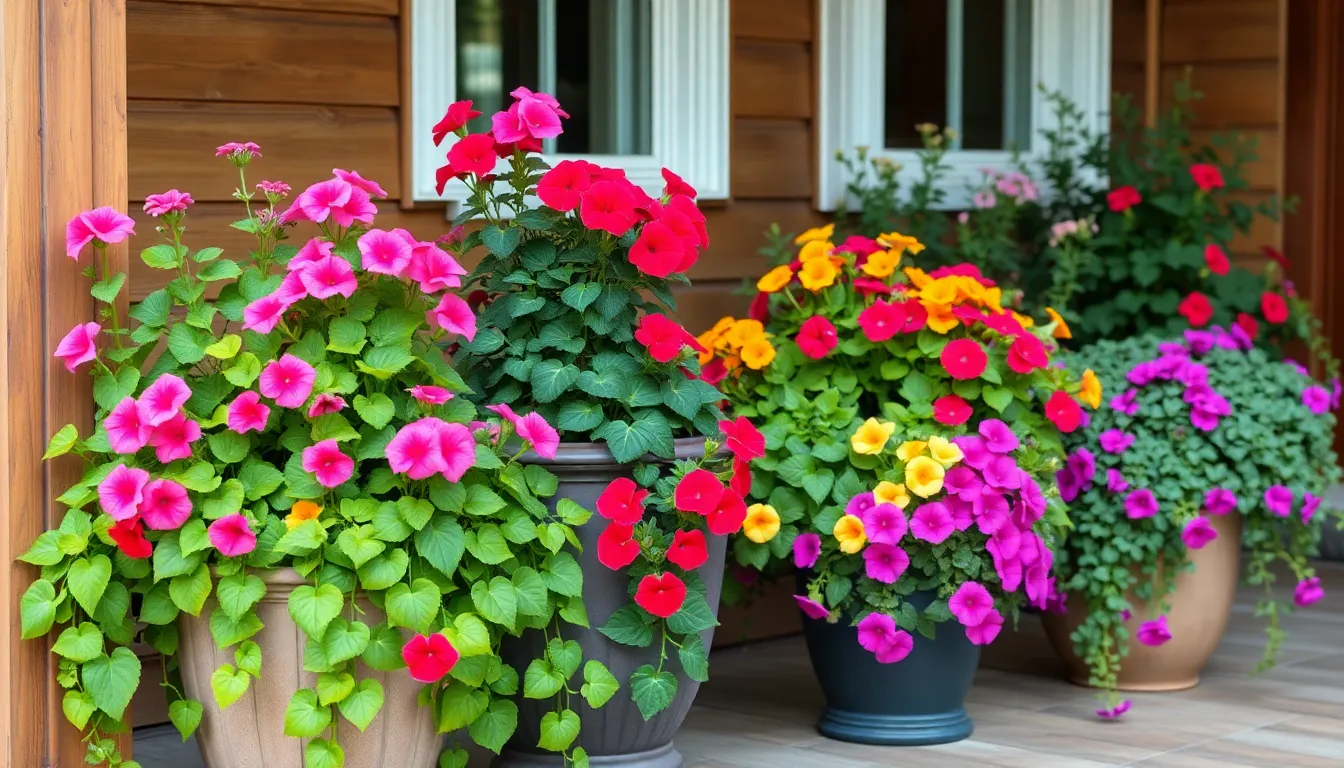
Container gardening transforms your front porch into a ever-changing industry that adapts to your changing needs and preferences. We can easily rearrange containers based on light conditions, weather patterns, or simply when we want a fresh design approach.
Select Weather-Resistant Planters
Fiberglass and plastic containers offer the most durability for year-round outdoor use since they resist cracking and withstand temperature fluctuations. We recommend these lightweight materials because they’re easy to move when rearranging your display and simple to clean when maintenance time arrives.
Galvanized steel tubs bring farmhouse charm to rustic porch designs, though we need to consider their placement in direct sunlight since metal containers can heat up quickly. Mixing different materials like ceramic pots with metal planters creates textural interest while ensuring each container suits your exact climate conditions.
Weather resistance directly impacts how long your investment lasts, so we always check that drainage holes are adequate and that materials won’t deteriorate under your local weather patterns.
Mix Textures and Colors in Each Container
Combining plants with contrasting leaf shapes creates visual depth that draws attention to your entrance. We pair broad-leafed plants like hostas with spiky ornamental grasses, then add trailing elements such as sweet potato vines to soften container edges.
Color layering works best when we use vibrant blooms against neutral foliage backgrounds. Pink geraniums pop dramatically when planted alongside silver-leafed dusty miller, while purple petunias create stunning contrast with chartreuse coleus.
Drought-tolerant succulents like sedum and echeverias provide texture variety with minimal water requirements. We often use these low-maintenance plants as anchor elements, then add seasonal color around them throughout the year.
Neutral containers in gray, terracotta, or natural wood tones let plant colors take center stage without competing for visual attention.
Create Seasonal Displays Throughout the Year
Spring bulbs like tulips and daffodils provide early season color when most perennial gardens remain dormant. We plant these in containers during fall, then enjoy their blooms as the first sign of seasonal transition.
Summer displays shine with heat-loving annuals such as petunias, salvia, and marigolds that maintain continuous blooms through hot weather. Rotating these vibrant performers keeps our porch looking fresh from June through September.
Hardy evergreens and ornamental grasses provide structure during winter months when flowering plants go dormant. We use these as backbone plants, adding seasonal elements like winter berries or decorative branches for holiday appeal.
Fall transitions become effortless when we swap summer annuals for mums, ornamental cabbage, and small pumpkins that celebrate autumn’s arrival. Container flexibility means we can adapt our displays faster than traditional garden beds allow.
Install Pathway Lighting for Safety and Ambiance
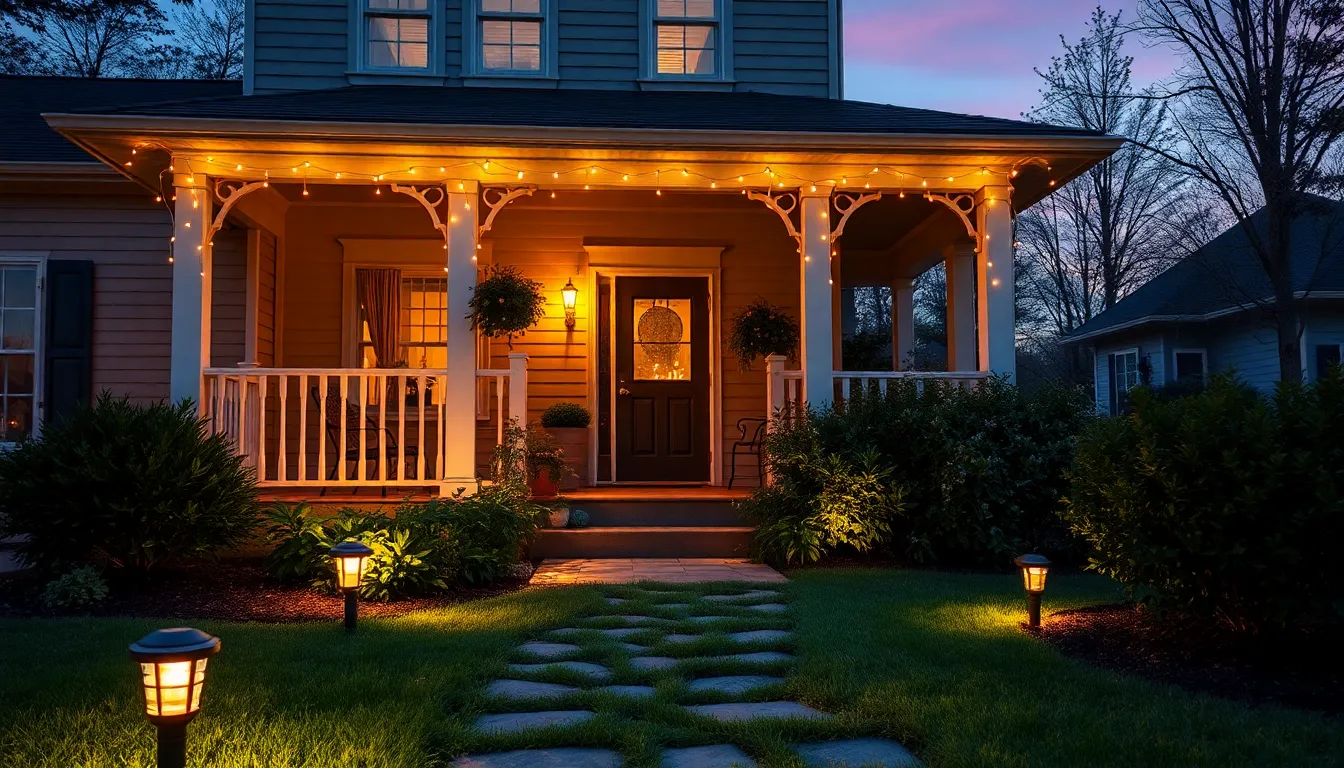
Pathway lighting transforms your front porch entrance into a safe and welcoming space after dark. Well-placed lights guide visitors along walkways while reducing trip hazards and creating an inviting atmosphere that extends your home’s beauty into the evening hours.
Choose Solar-Powered Options for Easy Installation
Solar-powered pathway lights offer the perfect solution for front porch landscaping without the complexity of electrical wiring. These environmentally friendly fixtures charge automatically during daylight hours and illuminate your walkway throughout the night. Installation becomes a simple weekend project since you won’t need to dig trenches or hire an electrician. We recommend spacing solar lights every 6 to 8 feet along your pathway for optimal coverage and visual appeal. Modern solar options provide reliable performance and come in various styles to complement your home’s architectural features.
Use String Lights for a Cozy Atmosphere
String lights create an enchanting ambiance that softens the harsh edges of traditional outdoor lighting. Draping them around porch railings, ceiling areas, or nearby plants adds warmth and intimacy to your front entrance. These versatile lights work beautifully for evening gatherings or quiet moments of relaxation on your porch. Edison bulb string lights offer a vintage charm, while LED options provide energy efficiency and longer lifespan. We suggest using warm white bulbs rather than cool white to maintain that cozy, inviting glow that makes guests feel welcome.
Highlight Key Plants With Spotlights
Spotlights showcase your carefully chosen landscaping elements by drawing attention to focal plants and architectural features. Adjustable spotlights allow you to customize lighting angles and intensity to emphasize the natural beauty and texture of shrubs, small trees, or flowering perennials. This technique adds dimension and visual interest to your front porch landscaping after sunset. Position spotlights at the base of plants and angle them upward to create dramatic shadows and highlight layered plantings. We recommend using LED spotlights for their energy efficiency and ability to produce crisp, focused beams that won’t overwhelm your landscaping design.
Build Raised Garden Beds for Better Drainage
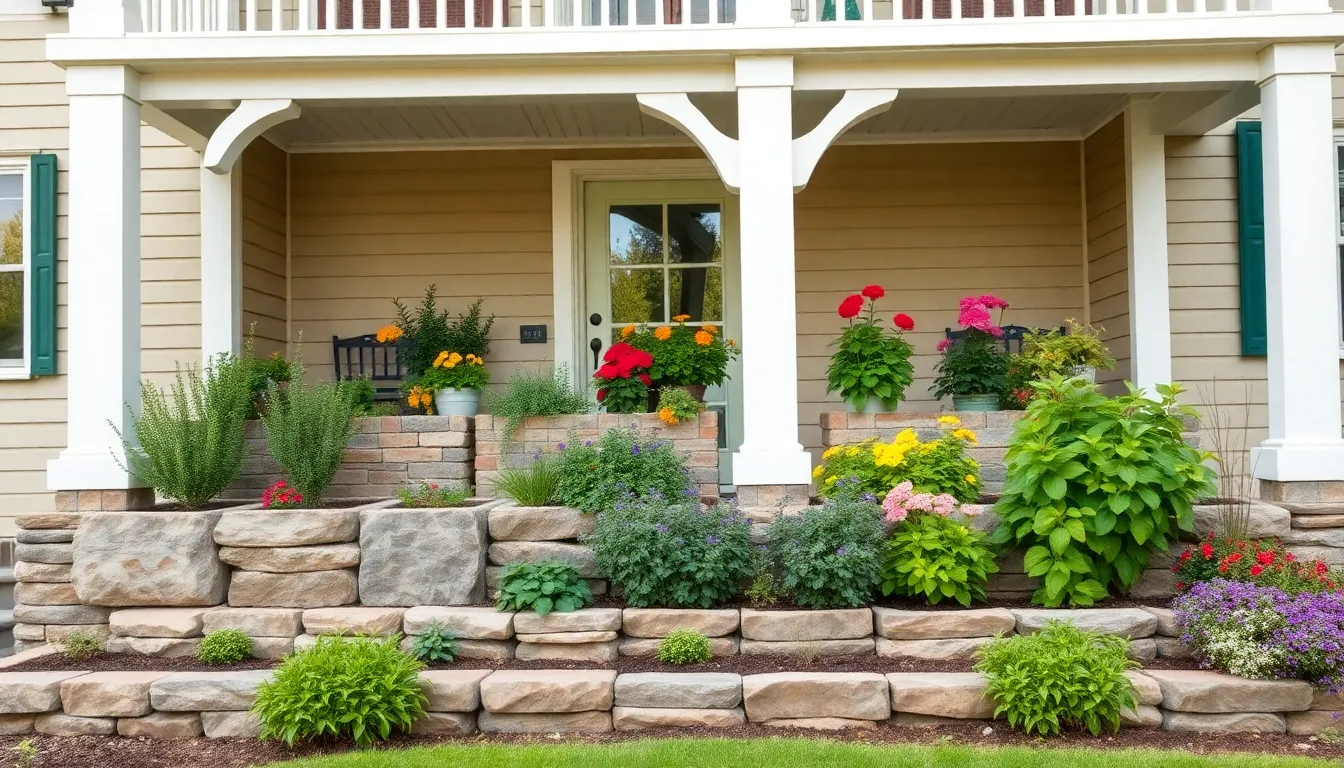
Raised garden beds transform your front porch landscaping by solving drainage issues while creating defined planting areas that enhance visual appeal. These elevated structures prevent water from pooling around your foundation, protecting both your home and plants from potential damage.
Use Natural Stone or Brick for Classic Appeal
Natural stone and brick materials elevate your raised beds with timeless elegance that complements various architectural styles. Stone pathways connecting your raised beds create visual continuity while adding texture and color contrast to your front porch industry. Brick edging around garden beds provides clean lines that define planting areas and prevent soil erosion.
We recommend choosing materials that match or complement your home’s exterior to create a cohesive look. Stone planters offer durability that withstands weather changes while maintaining their classic appearance year after year. These materials require minimal maintenance compared to wood alternatives, making them ideal for long term landscaping investments.
Plant Herbs for Both Beauty and Function
Herb gardens positioned in your raised beds offer dual benefits of visual greenery and fresh ingredients for your kitchen. Rosemary, lavender, thyme, and basil thrive in elevated planters where drainage keeps their roots healthy and accessible for harvesting. These aromatic plants attract beneficial pollinators like bees and butterflies to your front porch area.
We suggest grouping herbs with similar water and sunlight requirements to simplify maintenance routines. Mediterranean herbs such as oregano and sage perform exceptionally well in raised beds because they prefer the improved drainage these structures provide. Container grown herbs within raised beds allow you to rearrange your garden layout seasonally while maintaining easy access for cooking needs.
Create Tiered Levels for Dramatic Effect
Tiered landscaping introduces height variation that makes small front porch areas appear larger and more ever-changing through layered visual interest. Retaining walls at different elevations create natural platforms for showcasing various plant combinations from groundcovers to shrubs. Multiple levels allow you to display a diverse mix of perennials, annuals, and evergreens that create year round appeal.
We recommend starting with the tallest plants in back tiers and gradually decreasing height toward the front for optimal viewing from your porch and street. Natural slopes can be enhanced with terraced raised beds that prevent soil erosion while maximizing planting space. This layered approach transforms flat front yard areas into captivating landscapes that draw attention and create welcoming curb appeal.
Add Vertical Elements to Maximize Small Spaces
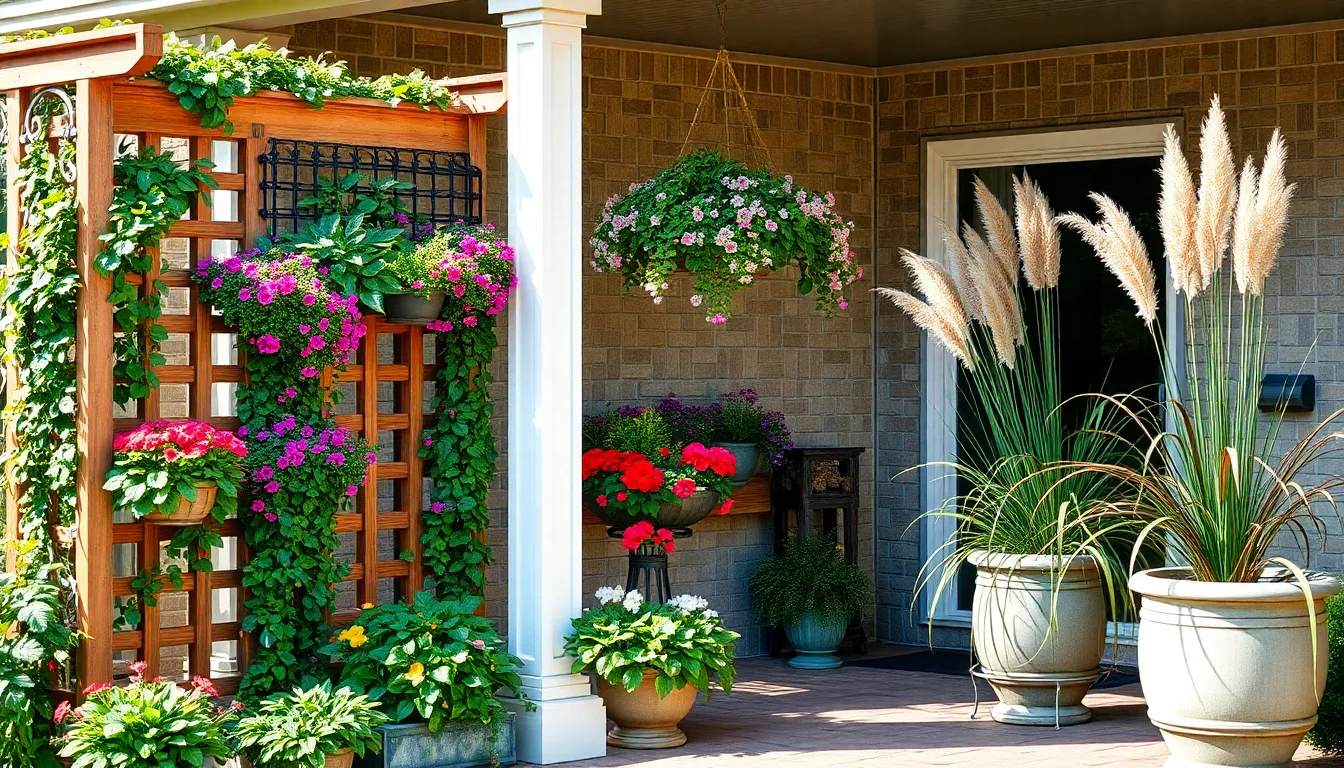
Building on our foundation plantings and container gardening strategies, we’ll explore how vertical elements can transform your limited front porch space into a lush, ever-changing industry that maximizes every inch.
Install Trellises for Climbing Vines
Installing trellises creates stunning living walls that draw the eye upward while conserving valuable floor space. We recommend positioning these structures along porch walls or near entryways to support climbing plants like ivy, clematis, or climbing roses. Trellises serve dual purposes by adding architectural interest and providing privacy screens as vines mature and fill in the framework.
Wooden or metal trellises work exceptionally well for different aesthetic preferences, with cedar options offering natural weather resistance. Choose climbing plants that suit your climate zone and light conditions for the best results. Clematis varieties bloom in different seasons, extending your porch’s visual appeal throughout the year.
Hang Wall Planters for Cascading Flowers
Hanging wall planters transform blank porch walls into vibrant displays without cluttering your walking space. We suggest mounting these planters at varying heights to create layered visual interest and depth. Trailing flowers like petunias, ivy geraniums, or cascading begonias work beautifully in wall mounted containers.
Select planters with proper drainage holes to prevent water damage to your porch walls. Position these containers where they’ll receive adequate light for your chosen plants while remaining easily accessible for watering and maintenance. Wall planters also offer flexibility to change seasonal displays without major landscaping overhauls.
Use Tall Planters as Natural Privacy Screens
Tall planters function as natural privacy screens while adding sophisticated vertical elements to your front porch design. We recommend placing these containers strategically at porch corners or beside seating areas to create intimate, sheltered spaces. Fill them with ornamental grasses, bamboo, or evergreen shrubs that provide year round screening.
Container heights of 24 to 36 inches work effectively for most privacy screening applications. Choose plants that won’t outgrow their containers quickly, such as dwarf varieties of boxwood or compact ornamental grasses like fountain grass. These tall planters also serve as architectural anchors that define different zones within your porch area.
Incorporate Hardscaping Features for Year-Round Interest
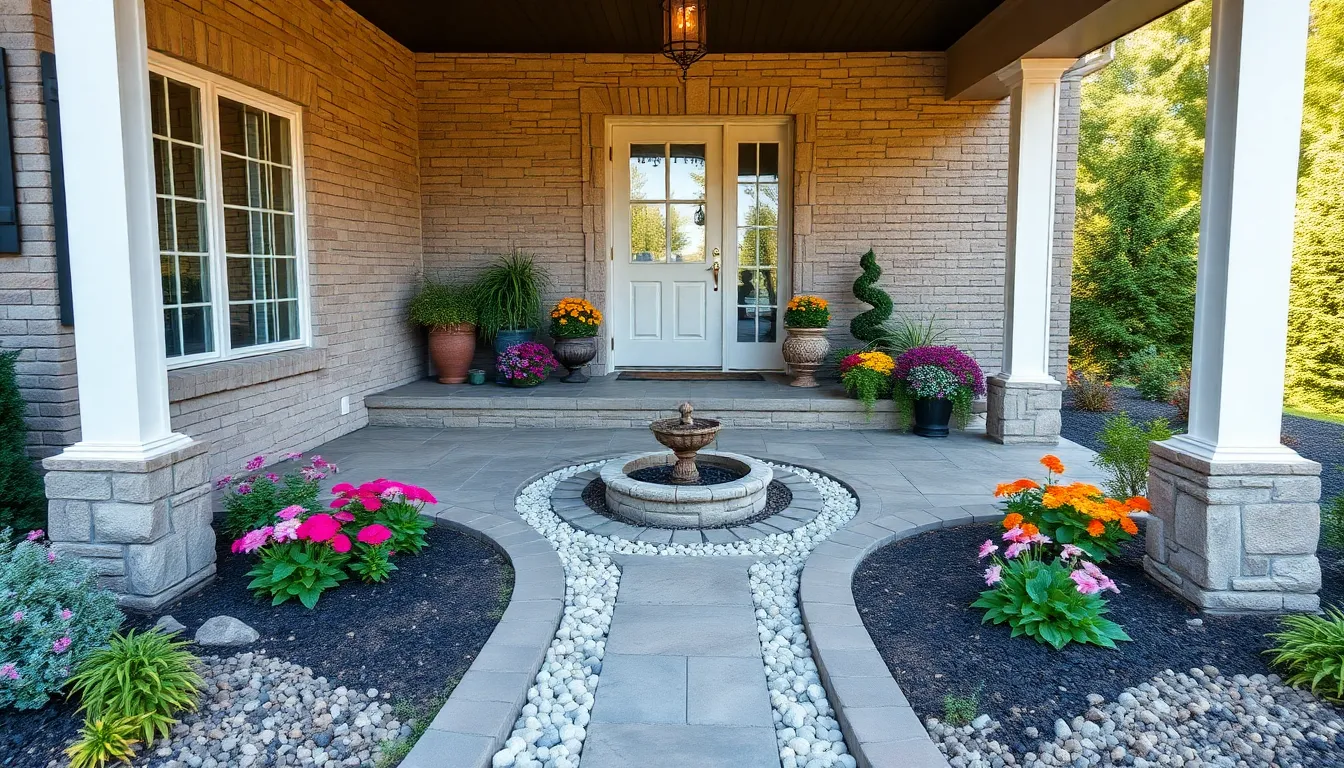
Stone patios and paver walkways create the foundation for a front porch that remains beautiful through every season. We can transform our entrance into a welcoming space by adding built elements that provide both function and visual appeal when flowering plants go dormant.
Add Decorative Mulch or Gravel Pathways
Decorative pathways guide visitors naturally toward our front door while adding texture and contrast to our landscaping design. Gravel offers excellent drainage properties and requires minimal maintenance compared to traditional grass or planted walkways. We recommend combining gravel with stepping stones to create a polished appearance that complements existing hardscape materials.
Mulch pathways work exceptionally well for creating defined routes through garden beds surrounding our porch area. Different mulch materials like cedar chips or decorative bark provide distinct visual textures that enhance the overall industry design. Edging materials help contain these pathways and prevent spillage onto adjacent lawn areas.
Install a Small Water Feature
Water features add soothing sounds that mask street noise while creating a tranquil atmosphere around our front porch. Small fountains serve as eye catching centerpieces that draw attention and provide natural movement to otherwise static industry designs. We can choose from tabletop fountains for container displays or larger ground installations that integrate seamlessly with surrounding plantings.
Pond features work well in corners or along walkways where they won’t interfere with foot traffic but remain visible from seating areas. These installations often attract birds and beneficial wildlife that enhance our outdoor experience. Solar powered options eliminate the need for electrical connections while providing eco friendly operation throughout daylight hours.
Create Defined Borders With Edging Materials
Edging materials create clean separation between different industry zones while preventing mulch and gravel from migrating into unwanted areas. Stone borders offer permanent answers that complement natural hardscaping elements and withstand weather conditions year after year. We can match edging materials to our porch construction materials for a cohesive design approach.
Metal edging provides sleek modern lines that work particularly well with contemporary porch designs and geometric planting layouts. Brick edging creates traditional appeal that pairs beautifully with classic home architecture and established garden styles. Plastic options offer budget friendly alternatives that still provide effective border definition while requiring minimal installation effort.
Choose Plants That Complement Your Home’s Architecture
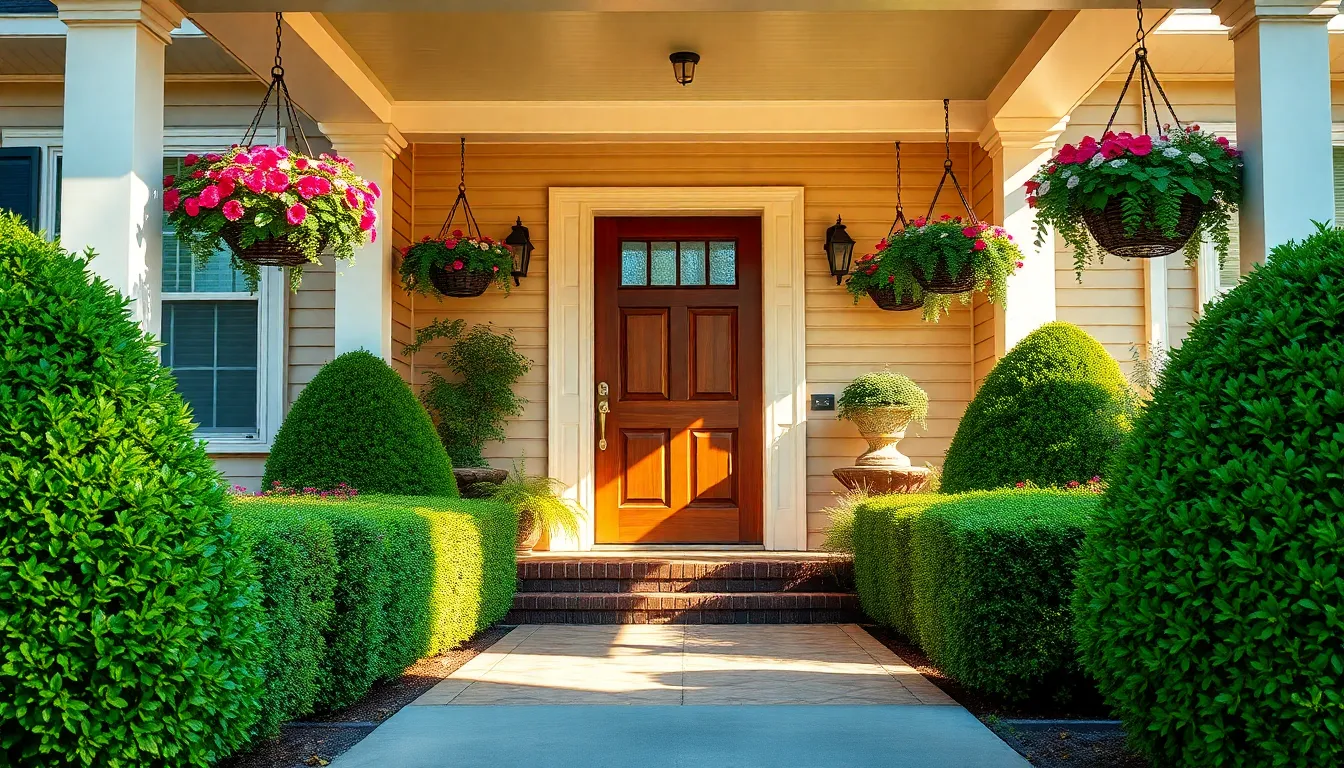
Plant selection becomes most effective when we align our choices with the architectural character of our home. Creating this harmony between hardscape and industry transforms ordinary front porch areas into cohesive, welcoming spaces.
Match Formal Gardens to Traditional Homes
Traditional homes flourish with symmetrical, formal garden layouts that echo their classical proportions. We recommend arranging neatly trimmed shrubs and hedges around walkways or directly flanking the porch structure for maximum visual impact. Flower beds positioned symmetrically on either side of the entrance create balanced focal points that draw visitors toward your front door.
Porch swings surrounded by structured greenery add charm while maintaining the formal aesthetic traditional architecture demands. Hanging plants like petunias, ivy, ferns, or spider plants enhance vertical interest without disrupting the organized flow. These elevated displays work particularly well when suspended at consistent heights to preserve the symmetrical theme.
Boxwood hedges serve as excellent foundation elements for traditional homes because they maintain clean lines throughout the year. We suggest pairing these with seasonal flower plantings in geometric patterns to add color while respecting the formal structure your home’s architecture requires.
Select Native Plants for Low-Maintenance Appeal
Native plants dramatically reduce maintenance requirements while ensuring optimal growth in your local environment. These species naturally thrive without extensive watering or fertilization, making them perfect choices for busy homeowners seeking beautiful results with minimal effort. Bird friendly plants such as coneflowers and dogwoods not only enhance visual appeal but actively support local wildlife populations.
Combining native selections with informal shrubs creates layered textures that require less frequent pruning than traditional formal gardens. Purple coneflower attracts pollinators while providing stunning late summer blooms that complement most architectural styles. Dogwood trees offer seasonal interest with spring flowers, summer shade, and vibrant fall colors.
We find that grouping native plants in clusters of three or five creates more natural looking displays than single specimen plantings. This approach mimics how plants grow in nature while providing the visual weight needed to balance your porch’s architectural elements effectively.
Consider Your Climate Zone and Sun Exposure
Climate conditions and sunlight patterns determine which plants will thrive in your exact front porch environment. Shade loving annuals work beautifully around trees or under porch eaves where direct sunlight remains limited throughout the day. Sun loving plants and flowering bulbs perform best when positioned in areas receiving six or more hours of direct sunlight daily.
Hanging baskets and containers offer flexibility for optimizing plant placement according to your porch’s unique light exposure patterns. We can easily move these portable gardens to follow seasonal sun patterns or protect sensitive plants during extreme weather conditions. This adaptability proves especially valuable for testing which plants perform best in different porch microclimates.
Temperature extremes in your climate zone influence both plant selection and container choices for year round success. Hardy evergreens provide structure during winter months when deciduous plants remain dormant, while heat tolerant annuals ensure continuous color during challenging summer conditions. Container materials also matter because some materials crack in freezing temperatures while others retain too much heat in intense summer sun.
Maintain Your Front Porch Landscape Throughout the Seasons
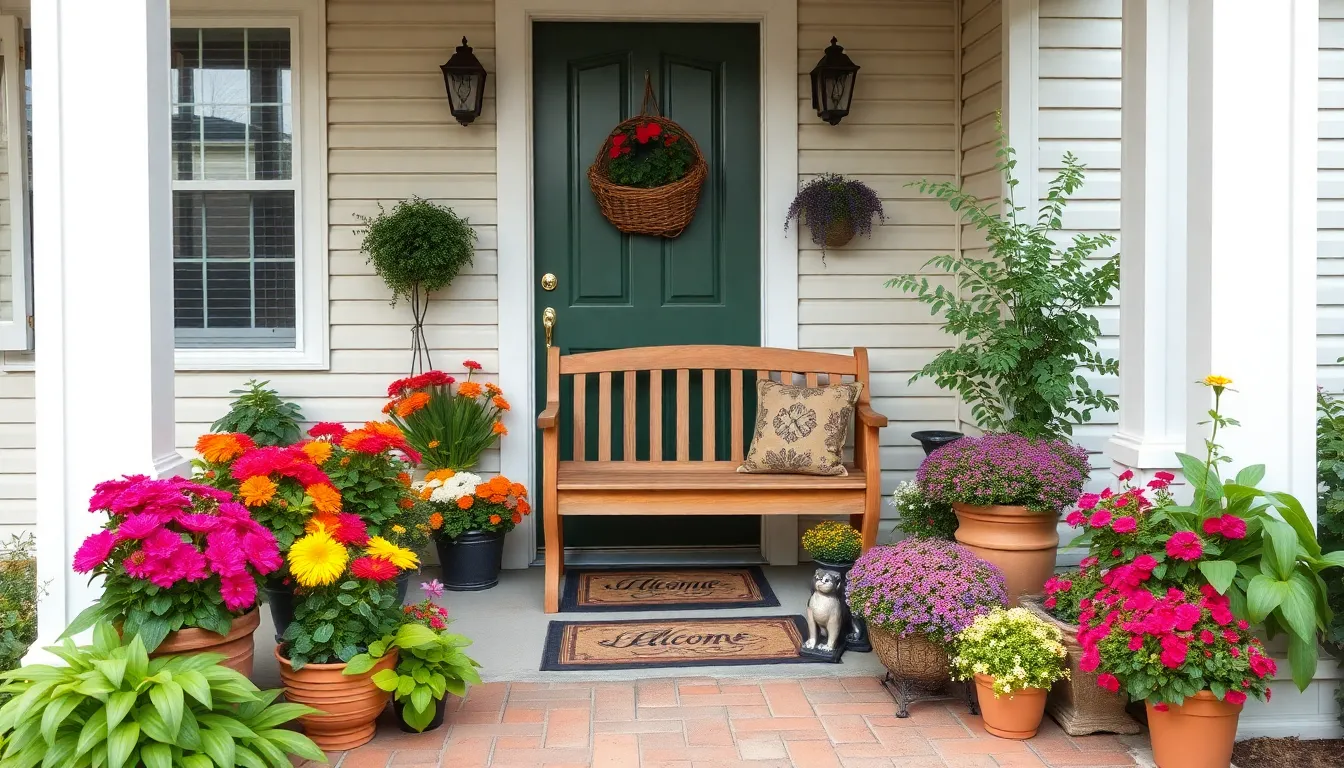
Maintaining our front porch industry year-round ensures it remains the welcoming entrance we’ve worked to create. Consistent care throughout different seasons keeps our plants healthy and our curb appeal at its peak.
Develop a Regular Watering Schedule
Establishing a watering routine customized to our plant needs and local climate helps ensure our front porch garden thrives. Drought-tolerant species like Russian sage and lavender require less frequent watering, making them excellent choices for busy homeowners. We should focus our watering efforts during dry months when plants face the most stress.
Mulching around our plants helps retain soil moisture and suppresses weeds, reducing the frequency of watering sessions. Container gardens on our front porch may need daily watering during hot summer months, while established perennials like hostas typically need watering only during extended dry periods. Creating a schedule based on each plant’s exact requirements prevents both overwatering and drought stress.
Plan for Seasonal Plant Replacements
Refreshing our porch industry with seasonal flowers maintains color and interest throughout the year. Early spring bloomers like pansies and tulips provide vibrant color after winter’s dormancy, while summer annuals keep our containers looking fresh during the growing season.
Fall presents opportunities to plant ornamental trees and shrubs such as Japanese maple or red twig dogwood that add autumn appeal and winter structure. We can swap out tired summer annuals for fall favorites like chrysanthemums and ornamental kale. Planning these seasonal transitions ensures our front porch never looks bare or neglected.
Azaleas offer spectacular spring blooms and work well as foundation plantings that require minimal seasonal replacement. Container gardening allows us the flexibility to change our displays easily without disturbing established industry beds.
Keep Up With Pruning and Deadheading
Regular pruning and deadheading promote healthy growth and extend blooming periods for our perennial plants. Removing spent flowers from plants like coral bells (heuchera) encourages continued blooming throughout the growing season. Boxwoods may need occasional trimming to maintain their shape and prevent them from outgrowing their designated space.
Dividing perennials like hostas every few years maintains their vigor and provides new plants for other areas of our industry. Spring pruning of ornamental grasses and shrubs removes dead growth and encourages fresh, healthy stems. Deadheading spent blooms on annuals keeps our containers looking tidy and promotes continuous flowering.
Timing our pruning activities correctly ensures we don’t accidentally remove next year’s flower buds or interfere with the plant’s natural growth cycle.
Conclusion
We’ve explored many ways to transform your front porch into a welcoming entrance that reflects your home’s character. From foundation plantings and container gardens to hardscaping elements and seasonal displays these landscaping strategies work together to create lasting curb appeal.
The key to success lies in choosing the right combination of elements that suit your exact space climate and maintenance preferences. Whether you opt for low-maintenance native plants or prefer the flexibility of container gardening the goal remains the same: creating an inviting atmosphere that welcomes guests year-round.
Remember that great front porch landscaping doesn’t happen overnight. Start with one or two elements that appeal to you most then gradually build upon your foundation. With consistent care and thoughtful plant selection your front porch will become the stunning focal point your home deserves.
Frequently Asked Questions
What are foundation plantings and why are they important for front porch landscaping?
Foundation plantings are strategic plant arrangements that visually connect your home’s architecture with the natural surroundings. They create a seamless transition between your house and landscape while providing year-round structure and color. Low-maintenance evergreen shrubs like boxwood, yew, and holly work best as they maintain their appearance throughout all seasons and require minimal care.
How can container gardening transform my front porch?
Container gardening offers flexibility and instant impact for front porch transformation. Use weather-resistant planters to mix different textures and colors, creating dynamic seasonal displays. This approach allows you to easily swap out plants throughout the year, experiment with arrangements, and work within any budget or space constraint while maintaining visual appeal.
What lighting options work best for front porch landscaping?
Solar-powered pathway lights and string lights are excellent choices for front porch landscaping. They enhance safety by illuminating walkways while creating a welcoming ambiance. Solar options are energy-efficient and easy to install without electrical work. Strategic lighting placement highlights your landscaping features and extends the enjoyment of your outdoor space into evening hours.
How do I choose plants that complement my home’s architecture?
Select plants that match your home’s style and scale. Traditional homes benefit from formal layouts with neatly trimmed shrubs and symmetrical flower beds. Consider your home’s colors, lines, and proportions when choosing plants. Native species are ideal as they thrive in local conditions, require less maintenance, and support local wildlife while naturally complementing regional architecture.
What’s the best way to maintain front porch landscaping year-round?
Establish a regular watering schedule based on plant needs and local climate. Use mulch to retain moisture and suppress weeds. Replace seasonal plants to maintain color and interest throughout the year. Regular pruning and deadheading promote healthy growth and extend blooming periods. Choose drought-tolerant species if you have limited time for maintenance.
How can I create visual interest in a small front porch space?
Maximize small spaces with vertical elements like trellises and wall planters to create living walls. Layer plants by height and use tiered landscaping to introduce variation. Incorporate raised garden beds for better drainage and visual appeal. Mix different textures, colors, and plant sizes in containers to create depth and dimension without overwhelming the space.

